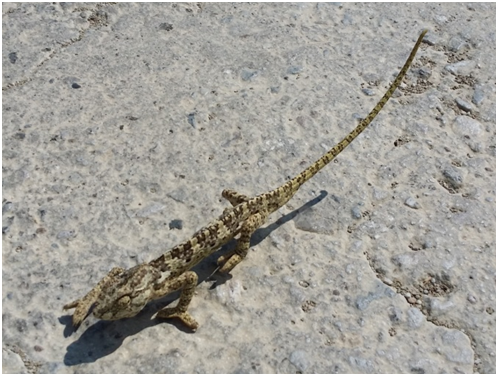I was driving on the island of Samos, where I was on vacation, when suddenly something was walking across the road. It was a chameleon walking with his characteristic gait. More specifically it was Mediterranean chameleon (Chamaeleo chamaeleon), also known as common chameleon and European chameleon.

Like other chameleons, the Mediterranean chameleon is well known for its long, sticky tongue which, when extended, can be twice the length of the body. Chameleons have very sharp eyesight and each eyeball is able to move independently of the other. The Mediterranean chameleon is well adapted to living in bushes and trees, with strong feet to hold firmly onto branches and a long, prehensile tail (Keren-Rotem, T et al, 2006). Is active during the day, and its diet consists mainly of arthropods including grasshoppers, flies, bees, wasps, and ants. Is preyed upon by snakes and domestic cats. (Pleguezuelos et al, 1999)
As shown in the image below is found in southern Europe, northern Africa and southwestern Asia. In Europe it is found in Malta, Samos (greek island) and in southern coastal Spain and Portugal where it is probably introduced before 1500 (www.iucnredlist.org)

Image 1. source: www.iucnredlist.org
Τhe only population in Greece is on the island of Samos

Image 2. Source: google earth
It is threatened locally by loss of habitat through urbanization and the development of tourist facilities, agricultural intensification, predation by domestic animals, accidental mortality on roads and by illegal collection of animals (www.iucnredlist.org) As you can see below I stretched out my hand and did not hesitate to go up. His nails flatten a little, since its nature is to go up in trees, but is very friendly. So although is a wild animal it is not afraid of man, which makes it more vulnerable.



Αfter a while we left it in his quiet. A really beautiful animal which needs our protection.


Referernces
Keren-Rotem, T., Bouskila, A. and Geffen, E. (2006) Ontogenetic habitat shift and risk of cannibalism in the common chameleon (Chamaeleo chamaeleon). Behavioural Ecology and Sociobiology, 59: 723-731.
Pleguezuelos, J.M., Poveda, J.C., Monterrubio, R. and Ontiveros, D. (1999) Feeding habits of the common chameleon, Chamaeleo chamaeleon (Linnaeus, 1758) in the southeastern Iberian Peninsula. Israel Journal of Zoology, 45: 267-276.
www.iucnredlist.org
the photos were taken with galaxy s4
Welcome to Steemit!
We have all been waiting for you, we are glad you could make it.
I have given you a upvote to help you out!
Hope you love Steemit as much as we do.
Give these a read:
Chat with us:
If this post was helpful, please leave an upvote. It helps me to keep helping new users.
I'm sunnybooster, a booster for accounts not posts. Send me 0.5 STEEM or SBD to get a week of upvotes! If you don't yet know what this is its fine.
I am a bot and this was automated. I exist to help out new members and attempt to get them hooked
Downvoting a post can decrease pending rewards and make it less visible. Common reasons:
Submit
your posts are well written and deserve more votes but please don't give up just keep posting and your rewards will come :)
Downvoting a post can decrease pending rewards and make it less visible. Common reasons:
Submit
thannks
Downvoting a post can decrease pending rewards and make it less visible. Common reasons:
Submit